Overhead toilet with an installation system: selection, installation

Suspended plumbing has only recently become popular among apartment owners. A few years ago, wall-hung toilets and sinks could be found mainly in public facilities - restaurants, hotels, nightclubs and shopping centers.
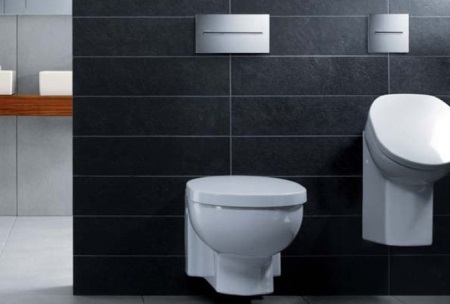
Advantages
The use of suspended sanitary ware in the bathroom in a regular apartment or in a private home has many advantages.
- First of all, such models attract by their non-standard appearance. Suspended plumbing looks original, easy to install and takes up much less space than the usual floor toilet with a cistern.
- The wall-hung toilet is attached to the installation system, which is hidden behind the false wall. Behind this wall, you can hide other communications and the sight of an unaesthetic layout of pipes will no longer annoy you.
- By the way, the free space on the floor makes cleaning much easier. Now you can wash the floor in the bathroom even with a mop or a vacuum cleaner.
- To install the wall-hung toilet, special installation systems are used, so you can move it quickly and easily.
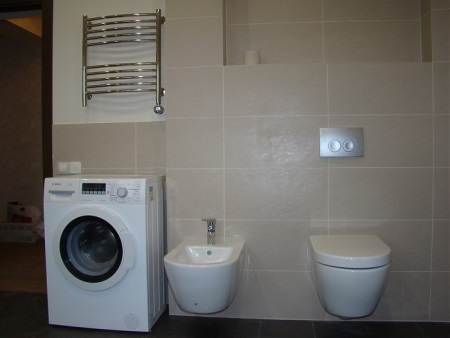
Types of installation systems
Depending on the design of the toilet bowl and the method of installation, there are several types of installation systems.
Block systems
Installations consist of two modules, one of which is hidden behind the false wall, and the second, the toilet bowl itself, is suspended from the solid wall or installed directly on the floor. Flush tank can also be hung from the wall, and you can immure, using bricks and cement and hide behind a partition, which is usually acted by drywall or plastic panels.
The block installation system is the most budget-friendly option. If you choose a model that involves the installation of the toilet on the floor, then its advantage relative to the simple toilet will consist only in the fact that the cistern is hidden from view behind the partition.
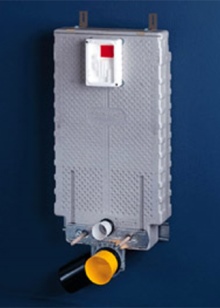
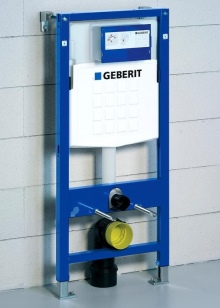
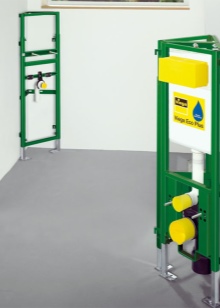
Frame system
At the heart of the frame system is a steel frame coated with a special corrosion-resistant material. Sometimes welding is used in the manufacture of such structures in order to ensure greater strength of the connection.
On the frame is all the main load: it must withstand the pressure of all the elements of the structure, water and the weight of the sitting person. An indisputable advantage of such a system is that it can be installed anywhere in the bathroom, to which you can bring water and sewage pipes.
Framed installation systems come in a variety of designs. Some of them are suitable exclusively for toilets, while others involve the possibility of installing different types of wall-hung plumbing.
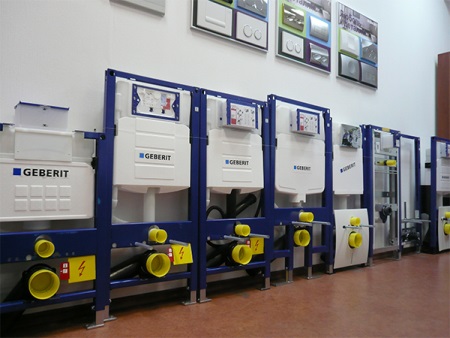
Universal models
Universal models Are also suitable for the installation of wall-hung sinks, bidets and urinals. Such designs have a set of mounts that allow you to adjust the height of sanitary devices. All communications are masked by decorative partitions.
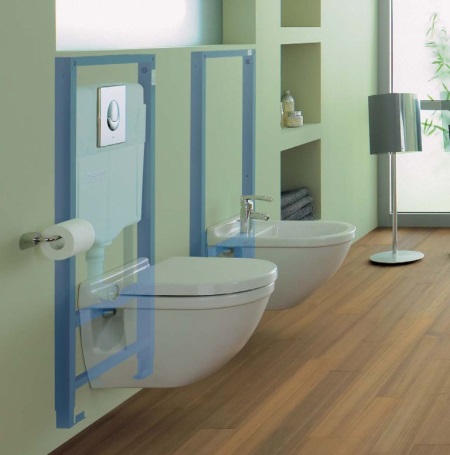
According to the place of installation models of wall-hung toilets can be subdivided into direct and angular.
- With straight models everything is very simple: they are installed at the wall.
- Angular models Mounted in a corner of the room, thereby helping to save space. However, buying a corner model only makes sense if it is installed in a combined bathroom. Buying a corner toilet for a tiny separate toilet, you are only wasting money, because in such a small space the space savings will be absolutely imperceptible.
Flush Panels
The flush panel of the wall-hung toilet, unlike all communications, is constantly in sight, so its appearance designers pay special attention. Buttons can be different in shape, size, located separately or be adjacent - there are countless options.
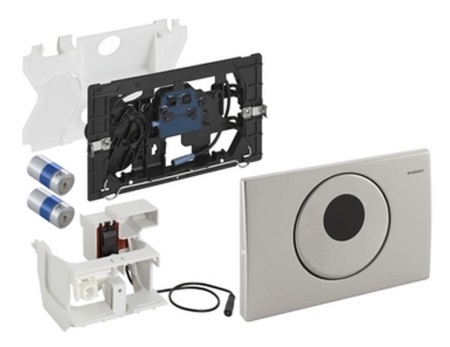
Experts advise to buy toilets with two buttons, which allow you to regulate the flow of water. Such a design helps reduce water consumption and make your monthly utility bill a little smaller.
A variety of materials are used to manufacture the flush plates.
- The most popular and budget-friendly option is plastic. If you purchased a quality product, it will serve you for a long time without losing its appearance.
- Flush plates made of chrome-plated steel are also available. Basically, such panels are equipped with sanitary facilities in public places, but in an ordinary apartment steel panel will look very effective. The advantage of this option is that such a panel is almost impossible to break. There is a disadvantage - chrome surfaces require constant care.
- For those who are always in search of original solutions, we can offer flush plates made of tempered glass. This is a very durable material, so you should not be afraid to use it. Glass panels can be matte or glossy, transparent or colored.
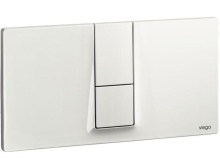
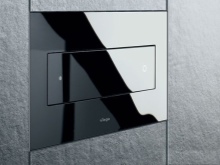
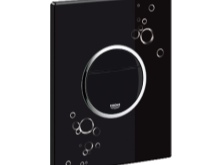
You can even find panels with decorative inserts of other materials. Separate mention should be made of the flush plates, which are created using the latest technology. These panels are equipped with sensors and infrared sensors which actuate the flush mechanism from the touch or heat of the hand. The flush plate, in addition to its basic function, performs another important function - in case of need for repair, it acts as a door, which opens access to the communications hidden behind the wall.
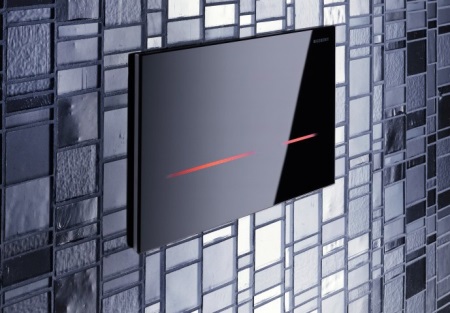
Parameters for choosing an installation
Installation - is a special system that allows you to install a wall-hung toilet or other sanitary device and hide all the communications going to it. This is quite a complex design, so its choice should be taken especially seriously.
Selection criteria:
- The characteristics of the place where it will be installed. This parameter includes the location and dimensions of the installation place. If it is a combined bathroom, the toilet bowl is usually mounted in a niche, which is created from sheets of drywall.
- Compatibility with the toilet bowl itself. It is better to buy these two elements of the design at the same time, under the guidance of an experienced sales consultant. If you prefer to buy in online stores, then first read the articles on specialized sites and familiarize yourself with the description of the goods. To avoid unpleasant surprises during installation, before installation, show all the documentation for the toilet bowl and installation system to the master who will do the work. You should pay attention not only to the compatibility of fixtures and communications, but also on whether the automatic system will function properly in the installed structure.
- Contents of the kit. Depending on the manufacturer there are different sets of accessories, so there is a chance that some elements you will have to buy yourself. Typically, the installation system is: a supporting frame, flush plate, fasteners and adapters, a cistern and soundproofing elements.
- Cost. The price of this product varies from several thousand to tens of thousands of rubles. It depends on the company-manufacturer and complexity of the design. The most expensive installations are produced by leading European manufacturers, such as "Geberit" or "Viega Eco". Prices for constructions with automatic flushing system, as a rule, are higher than for ordinary ones.
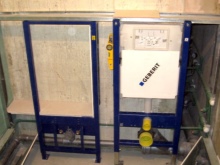
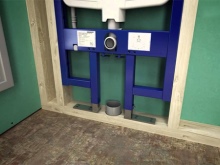
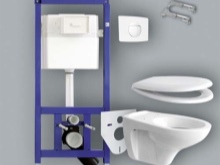
The size of the niche depends on the size of the installation. Mismatches can be avoided with the sliding system, which can be adjusted to the size of the niche. But when buying a sliding design, you need to take into account one important point: in the "spread out" form it is attached to the sides of the niche, and the entire load is on them. Therefore, such a system can be used only if the side walls you have solid or made of a material more durable than plasterboard, such as wood.
Installing
Stages of work on measuring and marking:
- First, draw a vertical line on the wall, which will be the center of the hanging structure.
- Measure the distance from the installation system to the solid wall.
- Mark the location of the cistern, usually at a height of one meter.
- Draw a marking, according to which the fasteners will be located, on the floor and walls.
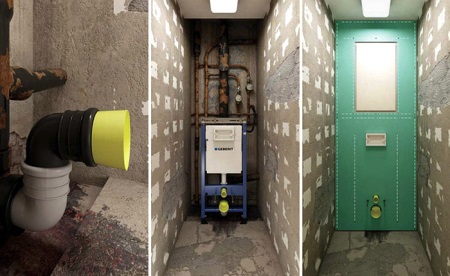
Work steps to install the fasteners:
- According to the prepared markings, drill holes and fix dowels in them. Insert anchors in the dowels. After you have prepared the fasteners, you can begin to install the main parts of the structure.
- Install the hanging installation and fasten it with the appropriate fasteners. Usually screws and nuts are used for this purpose. During installation, it is necessary to align the installation in the horizontal and vertical plane. For this purpose, the design provides special adjustable feet, clips and stopping plugs.
- Provide utilities. Water and wastewater pipes are secured to the structure with special plastic clamps. It is desirable to treat the joints of pipes with silicone sealant.
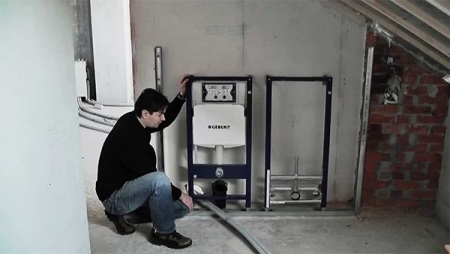
The final stage of installation is the installation of the toilet bowl.
Before this, it is necessary to prepare the connecting elements:
- to adjust the size of the pipes,
- equip the studs with couplings
- Lay a rubber gasket for shock absorption.
- Install the toilet bowl in place and tighten all connections.
Finishing the walls after installation
As has been said more than once, the main advantage of suspended plumbing is that it allows you to hide all the sewer and water supply, which makes the bathroom interior even more aesthetic. That is why finishing work after the installation of this kind of structures should be given special attention.
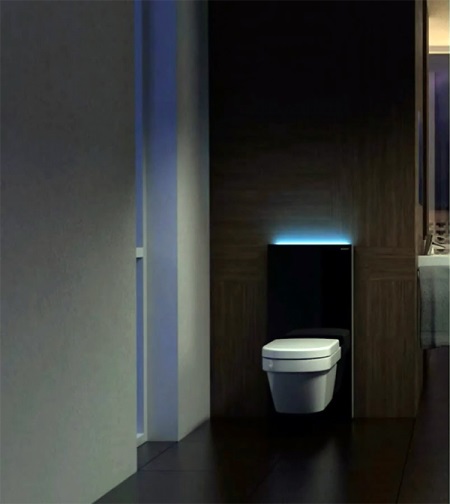
Usually all communications are hidden in a niche of plasterboard. This is very convenient, as even a non-professional can work with drywall. The material that is laid on top of the partition wall, everyone determines for himself.
Usually the same finish is used as on all the other walls in the room. As a rule, it is ceramic tiles and plastic panels.
You can play on the contrast and finish the niche, which is located in the overhead toilet, contrasting color or texture of the material. The main thing is to carefully hide all communications, otherwise the use of suspended plumbing loses its meaning.
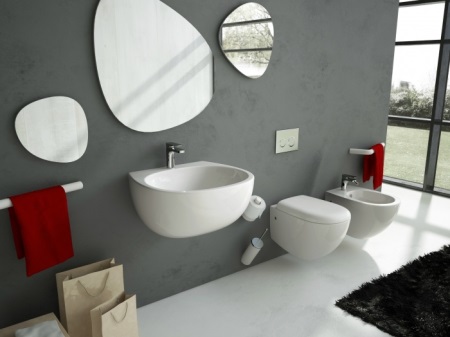





Because of the design will eat up space, of course, but hanging toilets give some kind of lightness. I really like it. Despite the disadvantages, I will put it up.